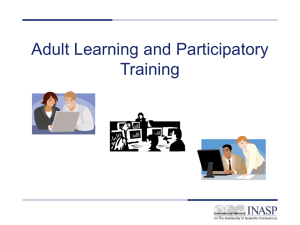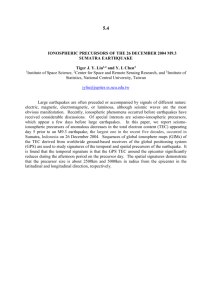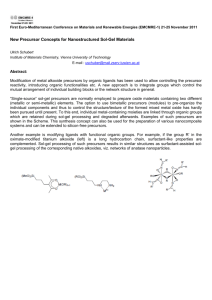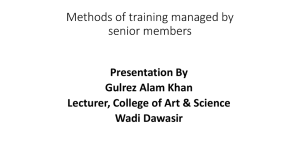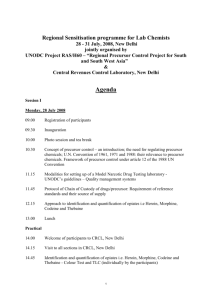BRIEF OVERVIEW OF PARTICIPATORY TRAINING METHODS
advertisement
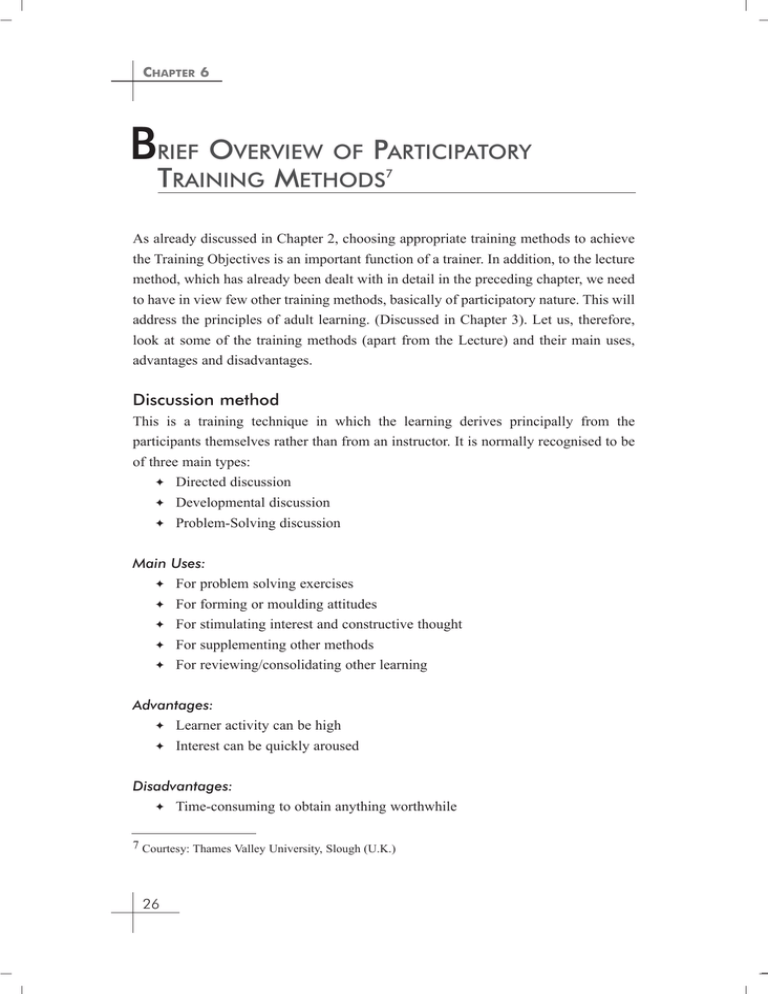
CHAPTER 6 BRIEF OVERVIEW OF PARTICIPATORY TRAINING METHODS7 As already discussed in Chapter 2, choosing appropriate training methods to achieve the Training Objectives is an important function of a trainer. In addition, to the lecture method, which has already been dealt with in detail in the preceding chapter, we need to have in view few other training methods, basically of participatory nature. This will address the principles of adult learning. (Discussed in Chapter 3). Let us, therefore, look at some of the training methods (apart from the Lecture) and their main uses, advantages and disadvantages. Discussion method This is a training technique in which the learning derives principally from the participants themselves rather than from an instructor. It is normally recognised to be of three main types: ✦ Directed discussion ✦ Developmental discussion ✦ Problem-Solving discussion Main Uses: ✦ For problem solving exercises ✦ For forming or moulding attitudes ✦ For stimulating interest and constructive thought ✦ For supplementing other methods ✦ For reviewing/consolidating other learning Advantages: ✦ Learner activity can be high ✦ Interest can be quickly aroused Disadvantages: ✦ Time-consuming to obtain anything worthwhile 7 Courtesy: Thames Valley University, Slough (U.K.) 26 BRIEF OVERVIEW OF PARTICIPATORY TRAINING METHODS ✦ Has to be extremely well controlled to be of value ✦ To run well, learners must know or have opinions about the topic Use in precursor control training Discussions are particularly useful in precursor control training in subjects such as: ✦ What kinds of control or controls over precursors are most suitable to the country? (especially useful for policy makers and senior law enforcement officers)? ✦ What are the existing loopholes in the legislative framework and how to plug them ✦ Discussion of cases of diversion/ attempted diversion of precursors and how to investigate them. Exercises Exercises require a small group of learners to undertake an activity either individually or together. The content of the activity is not important. What is important is how the individual undertook the activity and the results achieved. Experiential learning occurs when a person engages in some activity, looks back at the activity critically, abstracts some useful insight from the analysis, and puts the results to work. This is an inductive process, proceeding from observation rather than from a given truth. A structured experience provides a framework in which the inductive process can be facilitated. The experiences centre on a topic-related activity, where the trainees participate in, e.g., making products, transactions, problem solving, nonverbal communication, planning, competing, etc. The experiences so created provide the basis for learning. Main Use: Develop interactive/interpersonal skills, Team building activities. Advantages: ✦ Highly participative ✦ Learners are usually highly motivated Disadvantages: ✦ High trainer skills are required to review and help transfer of learning ✦ Failures may lead to frustration 27 GUIDE FOR TRAINERS Use in precursor control training Exercises are particularly useful in precursor control training in teaching field tests of precursors, drawing seizure reports preparing laboratory test reports (for chemists training), etc. Case study method This is a learning technique in which a real situation or series of events is presented to trainees for their analysis and consideration of possible solutions to the problems identified. Their findings can be compared subsequently with what actually occurred. Main Uses: ✦ Problem solving ✦ Developing analytical skills ✦ Identifying variables ✦ Gaining confidence in decision-making ✦ Changing/modifying attitudes ✦ Introducing and consolidating learning ✦ Teamwork Advantages: ✦ Provide concrete subjects for discussion ✦ Participants' experiences can be brought into use ✦ Provides opportunities for active participation Disadvantages ✦ Time consuming to produce good cases ✦ Difficulty in validating when there is no quantifiable solution ✦ Close relationship to 'real-life' may be difficult to achieve Use in precursor control training Case studies can be used to teach a variety of topics; often more than one topic can be explained through the same case study. Methods of diversion of precursors, techniques of collecting intelligence about diversion of precursors, investigating methods, identifying and dismantling illicit drug laboratories using 28 BRIEF OVERVIEW OF PARTICIPATORY TRAINING METHODS precursors are some of the topics which come to life when taught through case studies. The resource person who makes a presentation on case studies, however, should have current knowledge and should have been actively involved in investigation of cases. Role play This is a learning technique in which trainees are presented with a situation which they are required to explore by acting out the roles of those represented in the situation. Main Uses: ✦ For changing/modifying attitudes ✦ Developing interactive knowledge and skills Advantages: ✦ Can create a great deal of interest ✦ Active participation by role players ✦ Provides a 'living' example ✦ An exercise where emotions become the predominant feature Disadvantages: ✦ Observers may be passive until the exercise is discussed ✦ Success depends on the imagination of the players ✦ Attitude change may be short lived Use in precursor control training Often the accused get acquitted due to technical mistakes by the enforcement officers in documentation and officers and laboratory chemists not appropriately deposing in the court. An experienced defence counsel can often create a 'reasonable doubt' in the mind of the judge if the officers and chemists do not stand up to cross- examination. Both these aspects- appropriate documentation and testifying appropriately in the court can be best taught through mock court room sessions. Trainees can be given assignments of preparing documents about hypothetical cases. These documents can be examined and the 'officers' and 'chemists' who prepared them can be 'examined' and 'cross-examined' by working prosecutors and attorneys who actually handle drug and precursor cases during these mock court room sessions. 29 GUIDE FOR TRAINERS Brain storming This is a technique used for finding solutions by means of stimulating ideas. A small group of people with or without conscious knowledge of the subject meets and contributes any suggestion or idea that strikes them, no matter how fantastic or impossible it may sound. All suggestions are encouraged and criticism is not allowed at this stage, although contributors are later invited to explain their ideas. Subsequently, all the ideas submitted are sifted and assessed. Main Uses: ✦ Problem solving ✦ Consolidating previous learning Advantages: ✦ Uses participant' experience and ideas ✦ Very active participation Disadvantages: ✦ Time consuming ✦ High trainer skills required ✦ Some learners may not participate Use in precursor control training This method is ideal to deal with specific practical problems- say, growing seizures of ephedrine from a country or unusually large number of accidents and leakages from tankers of acetic anhydride during the previous six months. A brain storming session involving stakeholders- such as enforcement officers, regulators, representatives of trade and industry, transporters, users of these precursors can throw up a whole variety of ideas and viable practical solutions can emerge from such cross-fertilization of ideas. Field trip Field trip is a training method, which provides a dynamic environment near to or within the scenes of real action for learners to be a part of. It is a training method in which opportunities are provided to the learners to visit organisations, work sites, communities or villages, etc. with a view to observe, be a part of and collect 30 BRIEF OVERVIEW OF PARTICIPATORY TRAINING METHODS information to reflect, analyse and learn from. They use the experience undergone by them for learning during and after the trip. Field trips thus help create a dynamic learning environment. Main Uses ✦ To establish familiarity with or provide exposure to work culture, work practices, work conditions, constraints, etc. in organisations. ✦ To assure the practicality of new ideas. This in turn can generate thoughts on the various aspects to be considered for implementation of these ideas. These ideas could be useful to both the trainees and the host organisations. ✦ To secure first hand information from experienced people about the job, organisation, etc. ✦ To develop skills for managing uncertainties. ✦ To challenge pre-conceived views/perceptions. Advantages ✦ Ground realities of the learning environment increase trust in the learning tremendously. As learning during field trips is in job related situations, it is more effective compared to other methods. ✦ Can contribute equally towards learning by trainees and the host organisation, thus benefiting both. ✦ Scope for unintended learning is very high and can be tapped for further learning. ✦ Trainee participation and involvement is of very high degree. Disadvantages ✦ Very High demand on trainer on planning and preparation. ✦ Logistics and arrangements, if not done properly, can hamper achievement of desired objectives. ✦ There is a lot of dependence on external factors including host organisations, etc. Uncertainty is very high. Very high trainer skills are required to convert these uncertain situations into the rare learning opportunities that they are. ✦ Expensive as compared to other methods. 31 GUIDE FOR TRAINERS Use in precursor control training Field trips to laboratories testing precursors and to factories manufacturing and/or consuming them can give first hand experience to trainees about the way these precursors are manufactured, stored, packed, transported, consumed and the way the seized precursors are tested in the laboratories. 32
